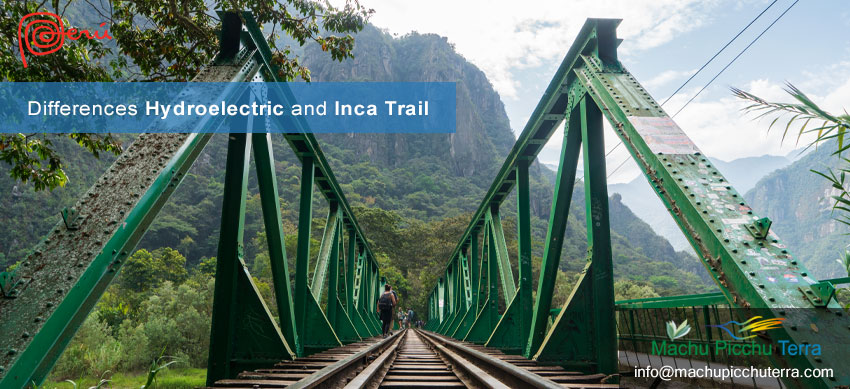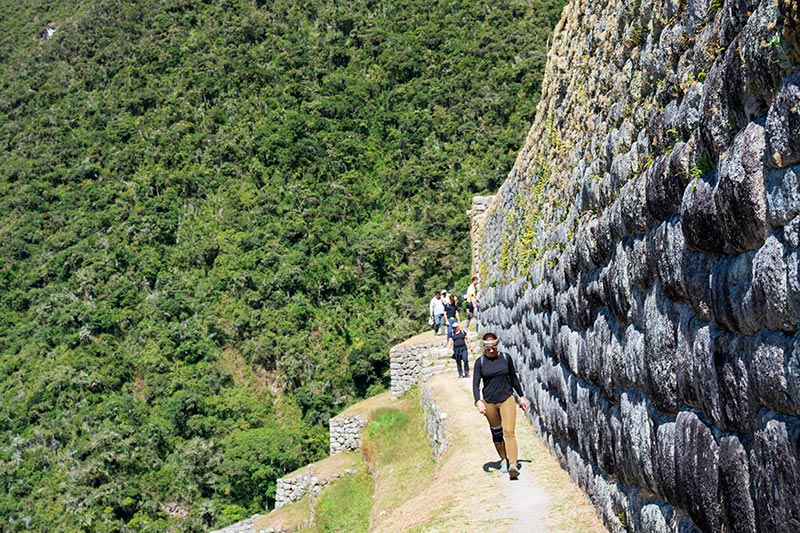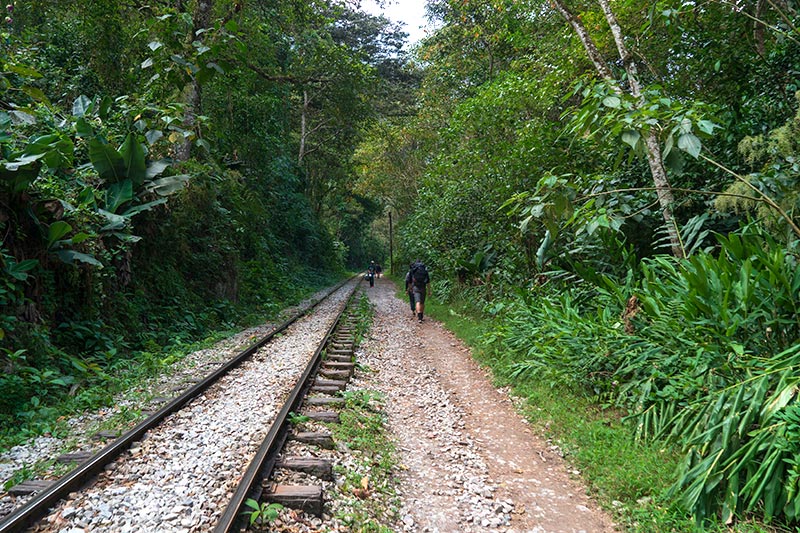
The short Inca Trail has a duration of 2 days as well as the Hydroelectric route. Both routes have Machu Picchu as their destination. That is why, in this blog, we want to talk about some particularities and characteristics of these two tours. This is so that you can stay without doubts and choose the option that best suits you. For example, there is a clear difference in prices and during the tour. They will also differ during the beginning of the trip, although both depart from Cusco we can find very different starts. All these details will be discussed in this brief article.
The Short Inca Trail
This route is a variation of the classic route of the Inca Trail to Machu Picchu. Although it has a duration of 2 days, from the first day you can already see the wonder of the world. In this sense, it can be considered one of the most beautiful routes that can be done on the way to Machu Picchu. From the moment you start the hike, you can see and visit the first archaeological center, being the first archaeological destination and also a favorite of this route. During the Classic or 4-day Inca Trail, you cannot visit Chachabamba, the archaeological site we have been talking about. Near Chachabamba, you can also find the control area, where the general public can use the restrooms and prepare their belongings to begin the hike. After, of course, registering at the entrance.
To complete this route, 11 kilometers must be covered. In this sense, it is important to start the hike early in the morning. The hike will begin in a geography very similar to that found in Cusco and Ollantaytambo, although in some sectors you can find some large trees. This will be an indication that we are close to the high jungle, where sometimes you can see these exchanges of flora and fauna of the place. For this reason, this route is one of the most requested by nature and bird lovers. In just one day of hiking, you can cross both geographies and witness the change in temperature and geography, in addition to the presence of some birds.
As with the classic 4-day Inca Trail route, this route includes some truly beautiful archaeological sites. Starting with the archaeological site of Chachabamba, passing through Wiñayhuayna, and arriving at Inti Punku. In the case of Chachabamba, we can find some typical Inca ruins and a temple that lies on a large stone. In the case of Wiñayhuayna, a place where we arrive at lunchtime, we can appreciate the change of geography that we mentioned. This place has one of the most amazing terraces and an architecture that is a challenge to gravity by the inclination of its terraces.
The arrival to Machu Picchu is made by the Inti Punku, the remains of a control area that surely served during the heyday of this Inca citadel. Approximately you arrive at this place in the afternoon just when the sun begins to hide between the mountains. This generates one of the most impressive views of Machu Picchu as it highlights the brilliance of the sun. That afternoon you will rest in Aguas Calientes or Machu Picchu town and the next day you will make the tour around the Inca archaeological site. In the afternoon we return by direct train to Cusco or by bimodal service.

Entrance to Wiñayhuayna archaeological site
The Hydroelectric Route
The hydroelectric route is considered the most economical option to reach Machu Picchu. This is even though the activity is done in two days. The route starts in Cusco but requires a long bus or minivan ride to Hydroelectric. The average travel time is 6 hours, counting some breaks during the trip. The route that follows may coincide with that of the short Inca Trail up to Ollantaytambo, but from that point, everything will change until you meet again at Machu Picchu town. After arriving in Ollantaytambo, you will pass through the Malaga pass to enter the jungle of the province of La Convención.
The districts that cross the province of La Convención, are Santa Maria and Santa Teresa de Choquequirao, after arriving at the latter destination you must make one more trip to reach Hydroelectric. From this place after having a well-deserved lunch, you start with the hike following the train tracks that connect Hidroelectric and Machu Picchu town. Normally, you can start this trip from 6:30 in the morning and arrive at your destination around lunchtime. The final hike lasts 2 hours at a good pace. This time can be increased in case you have a hike with long rests. It is estimated to arrive at Machu Picchu town between 17:00 and 18:00 hours of the day.
The hike is an easy section. There are no ascending or descending routes, the entire trail is flat. It is important that those who decide to do this route, keep in mind that it will be important to have an adequate lunch. During the hike, you will not find provisions, except when you arrive at Machu Picchu town. On the other hand, you will find some birds flying or singing among the trees. On the other hand, you will also be able to see some plants and leafy trees of a large size. For those who are more curious about part of a stretch, you can see part of the top of Huayna Picchu. Near this route is the Temple of the Moon, but access is restricted only to those who make the route to Huayna Picchu. Also, for the moment it remains closed.
The arrival at the archaeological site of Machu Picchu will take place the next day. After completing the hike from Hydroelectric you will arrive at the district of Aguas Calientes, as Machu Picchu town is also known. Upon arrival, it is recommended to find lodging, take a bath, or leave your belongings. After that, you can start a short walk to the thermal baths and relax your muscles. Before resting, it is recommended to have a proper dinner, have a light walk, and go to bed early. The next day you will visit the Inca archaeological site. The return is done by the same route in case you want to save money. But there is also the option of returning by train to Cusco or Ollantaytambo. Let’s see some similarities between both routes.
It is a small community that began to form from the families and workers of the hydroelectric plant of Machu Picchu. Later they began to make walking routes towards the wonder of the world. In this sense, they started with some restaurants and sales of drinks and snacks for travelers.

Traveling along the train tracks on the way to Aguas Calientes
Similarities between the Short Inca Trail and the hydroelectric route
- No Camping – When doing both routes we will not need camping equipment unless we want to spend the night in the camping area. This can be a problem because you would have to carry the equipment during the whole route. In addition, these services prioritize the facilities of a hotel for the comfort that they have.
- Distance – This point is a bit controversial and tells us about how time varies on the state or type of road. Both routes have approximately 11 kilometers of walking. But the time to do it varies considerably. You can do the Hydroelectric hike to Machu Picchu town in 2 hours. At the same time, the route of the Short Inca Trail takes between 5 and 6 hours without taking into account the relevant breaks.
- Safety – Both routes are safe. In the case of the Short Inca Trail, it has a month of protection throughout February. At this time, several workers are in charge of maintaining the route. In the case of the Hydroelectric route, this does not occur. In this sense, it is recommended to check the state of the road, especially during the rainy season, which can cause river overflows.
- Acclimatization – Acclimatization for these routes is not strictly necessary. However, if you feel some discomfort when you arrive in Cusco, it is recommended that you have a day of acclimatization before doing this route. Likewise, before booking you should anticipate this. In Cusco, you can do many activities to acclimatize before going to Machu Picchu.
- Travel season – This route, and any other route to Machu Picchu, can be complicated during the rainy season. Sometimes the rains are so heavy that the train tracks are closed. Under the same premise of safety, both routes of the Inca Trail are closed during February. In the case of the Hydroelectric route, it is necessary to do it with care and make previous consultations about the state of the road.
Differences Between the Short Inca Trail and the Hydroelectric Route
- Effort – The effort when doing these treks is completely different. To start with the journey that may be more comfortable for the Inca Trail. However, the main difference is in the trek. A greater effort is made on the Inca Trail route in addition to the fact that you walk for more hours. But all the effort is worth it for the landscapes that are appreciated.
- Travel time – The travel time in the case of the Hydroelectric route can reach 6 hours by minivan. While, for the Short Inca Trail, you can make a trip to Ollantaytambo of 2 hours and by train only about 1 hour and 15 minutes to Chachabamba to start with the hike. The difference is considerable but as we will see the costs are very different.
- Safety – Safety on the Short Inca Trail tends to be safer because of the maintenance and regulation of the route. Whereas, on the Hydroelectric route, there is no control or registration as such. Therefore, no maintenance or similar work is done.
- Reservation – It should be mentioned that the 2-day Short Inca Trail route has its ticket and its availability. Those who wish to do the route by Hydroelectric will have to make their respective reservation for the ticket that best suits them or attracts them. Remember that there are 5 options for tickets to enter Machu Picchu.
- Tour – During the tour the views that are appreciated are completely different. As we mentioned, hiking through the Andes and the mountains will let you see incredible views of the entire geography of the place starting in the Andes and ending in the high jungle. While the Hydroelectric route starts in flat terrain and directly in a tropical zone.
- Archaeological sites – Perhaps the main difference is at this point. During the Hydroelectric route, no archaeological sites can be found, only a small glimpse of Huayna Picchu in the distance. On the other hand, during the Inca Trail, several archaeological sites can be seen. Wiñayhuayna and Inti Punku stand out.
- Permits – The 2-day Inca Trail route must be done with the help of a travel agency. This is because it is a route of the Ministry of Culture and its care and maintenance are properly regulated. On the other hand, the route by Hydroelectric is free, it does not have a regulation. In this sense, it is recommended to do the route with care.
Comparison Chart
Data | Short Inca Trail | Hydroelectric route |
|---|---|---|
| Start of the walk | Chachabamba | Hydroelectric |
| Dates of entry | Closes in February | Check availability in rainy weather |
| Total cost of the tour | 430 to 455 USD | 60 to 120 USD |
| Walking Distance | 11 kilometers | 11 kilometers |
| Route details | Trocha, with steps | Flat terrain |
| Climate details | Temperate to Tropical | Tropical |
| Difficulties | Uphill sections | Ninguno |
By Inca Trail Machu Picchu - Last updated, 19-03-2024
Interested in the Inca Trail? Know more about Routes!
- Information about Maras – Moray, incredible adventure option
- What is the district of Lares like? Informative data
- Inca Trail to Machu Picchu – Family Route?
- Machu Picchu and Huayna Picchu – Entrance information
- Salkantay Trek 4 days how is the experience to get to Machu Picchu?
- Putucusi Mountain – Trekking Guide
